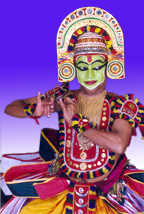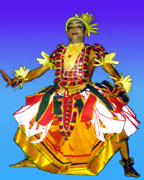Facial expressions, hand gestures and stylized footwork form the pertinent components of the body language. The art calls for a profound stamina and tenacity on the part of the performer as continuous body movements and verbal rendering go together for two or three hours. Often they need to perform twice or thrice in a day, on stages far away from each other. The basic tenets of the body language follow those observed by the schools of Kathakali and Krishnanattaom, two of the colourful dance drama styles popular in Kerala. However, in these forms the dancer-artists do not verbally delineate any of the subject contents, but Thullal artist does. The musical tunes and rhythmic scales are exclusively those of Kerala. Artists perform in front of a lit oil lamp, considering it as the presence of the Almighty.
The Three Styles Of Thullal
The 3 styles of Thullal are, Seetangan, Ottan and Parayan. An artist does facial make up by using the native pigments called Manayola (Yellow), Chayillyam (Red) Neelam (Blue) and Mashi (Black) mixed in coconut oil or water as required. Artists insert a specially processed floral part into the lower eyelids that turns the eyes red. This adds the aesthetic colour sensation and cools the eyes. In Seetangan and & Parayan styles the facial makeup is more realistic - a brightened skin tone with black lines to mark the eye definitions and red on the lips. Seetangan has decorations freshly made out of tender coconut palm leaves, golden beads and broad white and red cotton flaps around the waist. Ottan has no palm leaves used. Face is coloured green. Ornaments made out of light wood, golden beads and woolen fibbers and a very colourful headgear also made of wood decorated with gold foil, silver, mirrors and beads, render to the Ottan artist the stylized identity and concept of Lord Vishnu. Seetangan is supposed to represent a jungle goddess who tells the stories of wisdom to the yearning audience. Parayan wears the least of decorations. He wears a wooden headgear symbolizing Lord Shiva who tells stories of devotion and spiritual truth to the audience. In Parayan the broad cotton flaps are substituted by a white cotton cloth above which a red one is worn. Unlike the other two types, the Parayan wears anklets only on the right leg.
Serious readers may note that there are other types of Thullal viz. Sarppam Thullal, Gandharvan Thullal etc. which are ritual arts with rich audio-visual elements.






The Art Forms of Kerala THULLAL